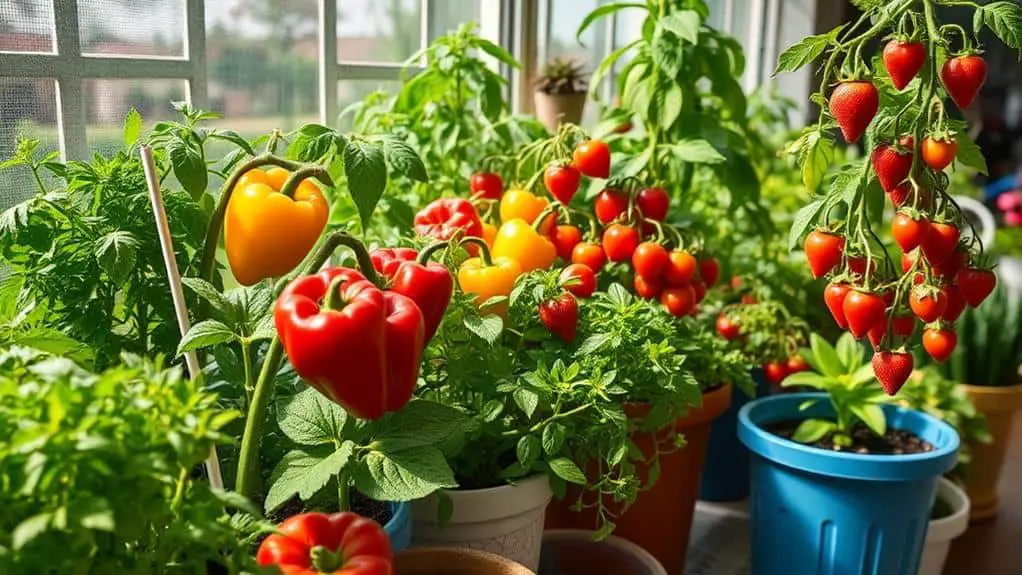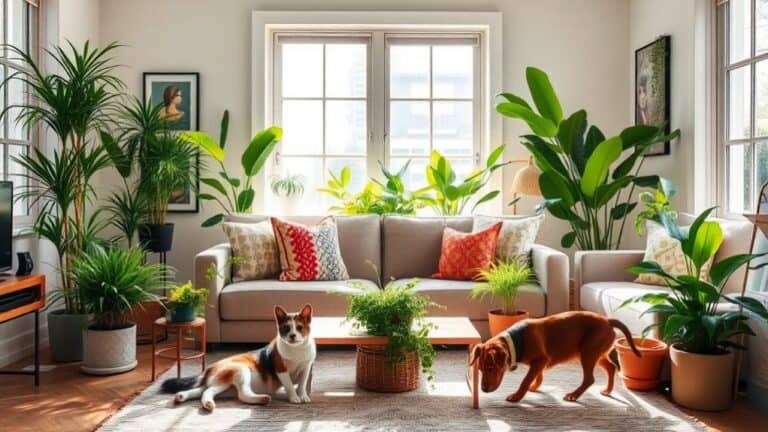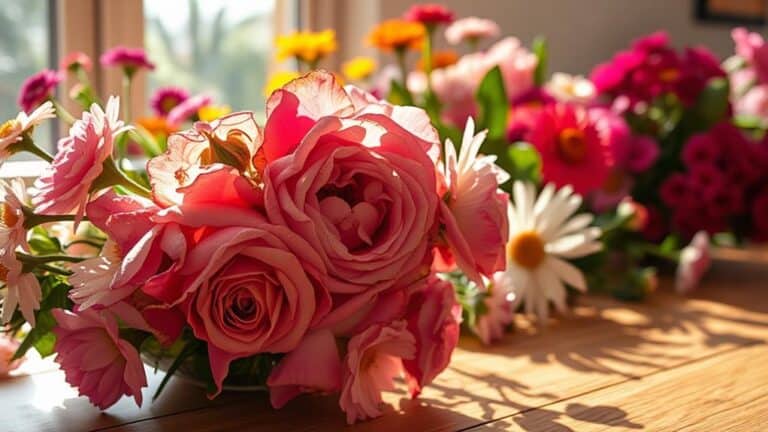Fruits And Vegetables You Can Grow Indoors Year Round
I've found that growing fruits and vegetables indoors year-round is not only a practical way to guarantee a steady supply of fresh produce, but also a satisfying hobby. Imagine harvesting your own Meyer lemons, juicy strawberries, or even small banana varieties right from your living room. It's amazing how with just a bit of bright light, some humidity, and regular care, you can turn your indoor space into a mini-garden. Curious about how to get started and which plants thrive best? Let's explore the ins and outs of indoor gardening together.
Meyer Lemons
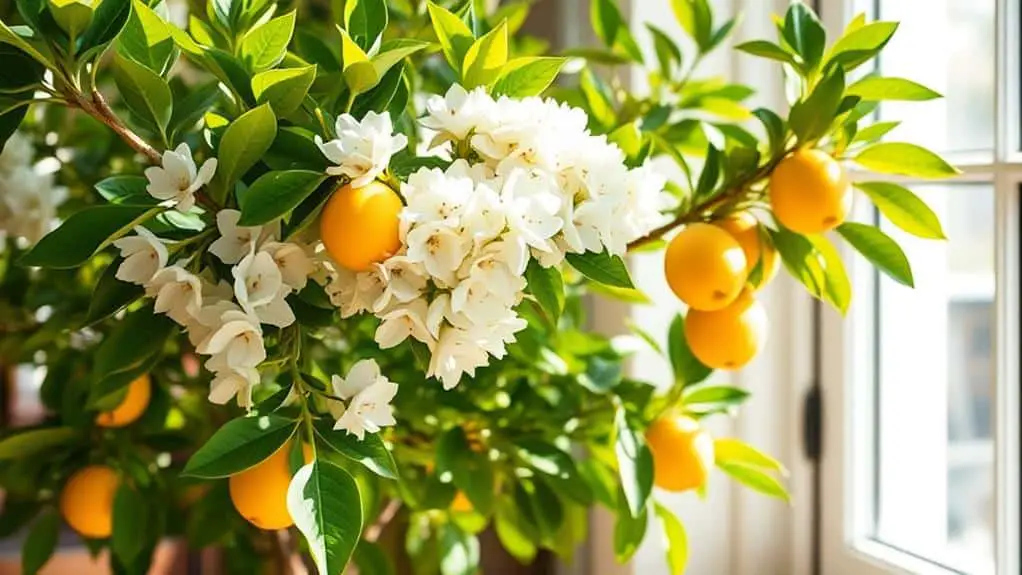
If you're looking to add a touch of citrus to your indoor garden, Meyer lemons are a fantastic choice. These trees thrive indoors with plenty of bright light, so place them near a south-facing window or use a grow light.
They require higher humidity levels, which you can maintain with a humidifier or a pebble tray filled with water beneath the pot. Unlike many citrus varieties, Meyer lemons don't go dormant and enjoy consistent light year-round, leading to continuous fruit formation.
You might need to hand-pollinate the flowers using a small brush to transfer pollen. The resulting lemons are sweet, flavorful, and smaller than traditional lemons, making them a delightful addition to your indoor garden.
Give it a try!
Indoor Tomatoes
Growing indoor tomatoes is a rewarding experience, especially if you choose smaller varieties like Toy Boy or Tiny Tim.
Make sure you place them in a pot that's at least 6 inches deep for healthy roots and give them 6-8 hours of sunlight daily, either from a south-facing window or grow lights.
Don't forget that hand-pollination and regular watering are key, and using a balanced fertilizer every few weeks will help your plants thrive.
Light Requirements
Ensuring indoor tomatoes get adequate light is vital for their success. To grow healthy fruit indoors, tomatoes need at least 6-8 hours of bright light each day. South-facing windows are ideal, but if that's not possible, you can use grow lights. Smaller varieties like Cherry or Tiny Tim tomatoes thrive in indoor conditions, especially with well-draining soil.
Here's a quick guide to light requirements:
| Light Source | Duration Needed | Benefits |
|---|---|---|
| South-facing windows | 6-8 hours daily | Natural, cost-effective |
| Grow lights | 12-16 hours daily | Consistent, adjustable intensity |
| Combination | 8-10 hours natural + 6-8 hours artificial | Best of both worlds |
Regularly checking and adjusting your light setup is important. Too little light can lead to poor fruit and pest problems.
Pollination Techniques
Hand-pollinating indoor tomatoes is crucial for fruit production since natural pollinators are absent. Gently shaking the plant or using a small brush to transfer pollen between flowers can effectively aid this process.
You can also use a fan to mimic wind and help distribute pollen. Pollination is most effective when the indoor temperature is between 70°F and 80°F, encouraging flower development and fruit set.
For peak fruit production, guarantee your indoor tomato plants get at least 6 to 8 hours of bright light daily. Regularly check for male and female flowers to maximize pollination opportunities.
Container Selection
Choosing the right container for your indoor tomatoes can make all the difference in their growth and fruit production.
When it comes to container selection, it's crucial to pick pots that are at least 6 inches deep to accommodate the roots. Larger tomato varieties need a large pot, ideally 12 inches in diameter, to guarantee they've ample space.
Always choose containers with drainage holes to prevent water buildup. Unglazed clay pots are great for airflow, maintaining soil moisture and temperature.
Well-draining soil is key to keeping your indoor vegetable garden healthy. Self-watering pots can also help maintain consistent moisture levels, meeting your plant needs.
With the right container, your tomatoes will thrive indoors year-round!
Growing Bananas
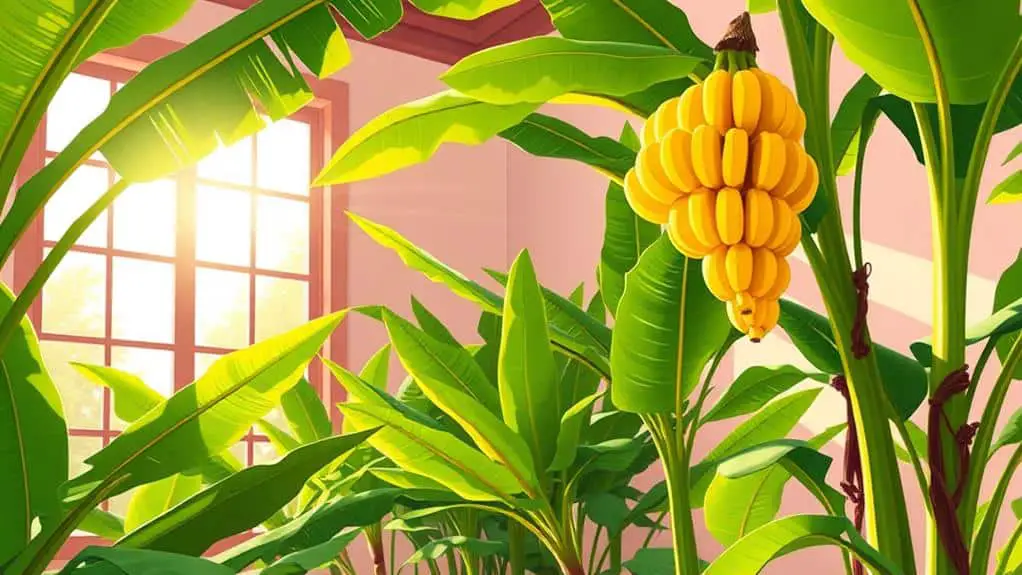
Growing bananas indoors is totally doable, especially if you choose a dwarf variety that fits well in smaller spaces.
They need warm temperatures, high humidity, and lots of light, so placing them near a south-facing window or using grow lights is key.
With the right care, including well-draining soil and regular watering, you can look forward to harvesting your own bananas in about a year.
Optimal Growing Conditions
When cultivating bananas indoors, ensuring they've ideal growing conditions is key to their success.
Start with a large container filled with well-draining potting mix, at least 12 inches deep. Bananas need warm temperatures between 75°F and 95°F. Place them in bright, indirect light to promote healthy growth.
To maintain the tropical environment they love, keep humidity levels around 50-60% with regular misting or a humidifier. A balanced, slow-release fertilizer every 6-8 weeks supports their nutrient needs as they grow.
Care and Maintenance
Caring for indoor banana plants involves a few key practices to confirm they thrive year-round.
First, make sure they get bright, indirect light for at least 12 hours a day. Place them near a south-facing window or use grow lights.
Keep the temperature between 75°F and 95°F, and maintain high humidity by misting regularly or using a humidifier.
Watering is essential; keep the soil consistently moist but not waterlogged. Use a balanced fertilizer every few weeks.
A pot at least 12 inches in diameter guarantees enough room for growth.
These care and maintenance steps will help your banana plant flourish indoors. By following these guidelines, you can enjoy fresh, homegrown bananas all year long.
Harvesting Indoor Bananas
After guaranteeing your indoor banana plant receives proper care and maintenance, let's explore how to harvest the fruits of your labor. Growing bananas indoors involves attention to light, humidity levels, and feeding. When your dwarf banana tree, standing at 3 to 4 feet, finally produces clusters of bananas, you'll want to harvest them at the right time. Typically, it takes about 9-15 months to harvest ripe bananas, depending on conditions. Keep the humidity around 50-60% with regular misting and guarantee they get bright indirect sunlight for at least 12 hours daily. Use a balanced fertilizer every 2-4 weeks. Here's a quick guide:
| Step | Description |
|---|---|
| Check Ripeness | Bananas should be yellow |
| Cut the Cluster | Use a sharp knife |
| Lower Carefully | Support the cluster with your hand |
| Store Properly | Keep in a cool, dry place |
Container Strawberries
Growing strawberries in containers offers a delightful way to enjoy fresh fruit year-round, even when snow blankets the ground outside.
Container strawberries, especially day-neutral varieties, grow quickly and thrive indoors. They need ample light and consistent moisture, so aim for at least 6-8 hours of bright light daily.
Make sure the crown of the plant stays above the soil to prevent rot. Hand-pollination helps boost fruit production; use a small brush to transfer pollen between flowers.
Regular fertilization with a balanced fertilizer supports their growth and fruiting.
Avocado Trees
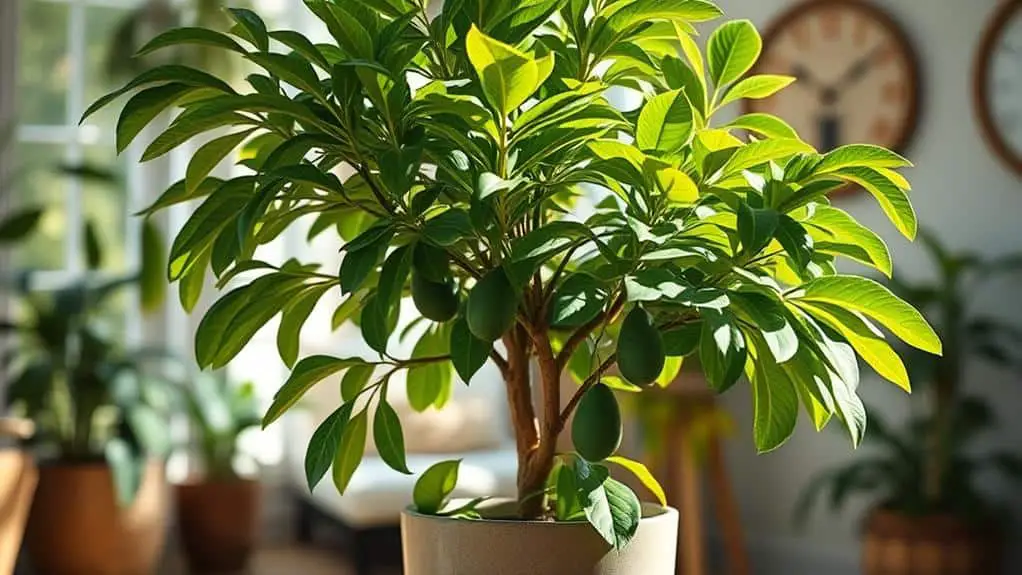
For those of us who love fresh avocados, growing an avocado tree indoors can be incredibly rewarding, if a bit challenging.
Avocado trees thrive indoors and need a minimum of six hours of direct sunlight daily. A south-facing window works best.
Use well-draining soil and a container with drainage holes to prevent root rot. Regular watering is key, but let the top inch of soil dry out between waterings to avoid overwatering.
Fertilization is important too. Feed your tree with a balanced fertilizer every four to six weeks during the growing season.
With some patience and care, you can enjoy homegrown avocados in a few years, or sooner if you start with a grafted tree.
Happy growing!
Lettuce Varieties
When it comes to growing vegetables indoors, lettuce varieties like Baby Oakleaf and Tom Thumb stand out as excellent choices. These lettuces are perfect for indoor growth because they've compact sizes and shallow root systems, needing only 4-6 inches of pot depth.
They thrive with 6 to 8 hours of indirect sunlight daily, so place them near a bright windowsill or use grow lights. Keep the soil consistently moist, but not waterlogged, to avoid root rot.
Harvest the outer leaves when they reach about six inches tall. This allows the inner leaves to keep growing, providing multiple harvests.
Growing lettuce indoors year-round means fresh salads anytime, making it a convenient and rewarding choice.
Indoor Carrots
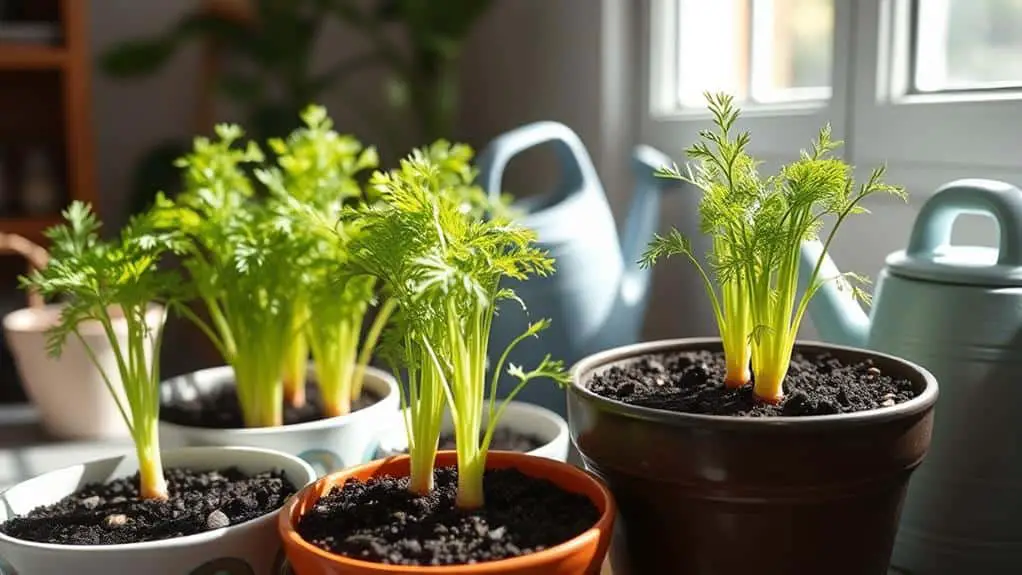
Although often overlooked, indoor carrots can be a delightful addition to your home garden. Small varieties like Little Finger or Royal Chantenay thrive in containers that are at least 8 inches deep, allowing their roots to develop properly.
They're easy to grow indoors if you keep the soil moist and guarantee they've good drainage. Sow the seeds shallowly, about 1/8 inch deep, and remember that they need light to germinate, which takes around 2-3 weeks.
Carrots prefer cooler temperatures, perfect for indoor growth during fall and winter. Regular thinning of seedlings prevents overcrowding, helping each carrot grow to its full size.
Applying liquid fertilizer bi-weekly boosts their growth and enhances flavor.
Kale Plants
When growing kale indoors, you'll find it thrives with at least six hours of indirect sunlight each day and prefers cooler temperatures, making it perfect for both spring and fall.
I recommend using pots that are at least six inches deep to support its roots, and remember to keep the soil consistently moist.
This leafy green isn't only packed with nutrients but also allows for multiple harvests, as you can pick the outer leaves while letting the inner ones keep growing.
Optimal Growing Conditions
Kale plants flourish best under specific growing conditions, so it's essential to get the basics right.
First, make sure your kale gets at least six hours of indirect sunlight daily. A south-facing window or grow lights work well.
Ideal growing conditions also include keeping the temperature between 60-70°F. Use nutrient-rich, well-draining potting soil to give your plants a good start.
Water regularly to keep the soil consistently moist, but be careful not to overwater. Every few weeks, use a balanced fertilizer to maintain nutrient levels.
With these steps, your indoor kale will thrive, giving you fresh leaves to harvest multiple times throughout the year. Trust me, you'll love the results!
Nutritional Benefits
You won't believe how nutritious kale is! This leafy green packs a punch with its incredible nutritional benefits.
Kale is loaded with vitamins A, C, and K, and essential minerals like calcium and potassium. Just one cup of cooked kale gives you over 1000% of your daily vitamin K needs, which is crucial for bone health and blood clotting.
It's also rich in antioxidants like quercetin and kaempferol, helping to reduce inflammation and oxidative stress. The high fiber content supports digestive health and helps maintain healthy cholesterol levels, which is great for your heart.
Plus, its phytonutrients and vitamins can lower the risk of chronic diseases like heart disease and certain cancers. Growing kale indoors means year-round access to this superfood!
Indoor Care Tips
Growing kale indoors guarantees a steady supply of this nutritious green throughout the year. Here are some indoor care tips to help you succeed.
First, choose well-draining pots filled with nutrient-rich soil. Kale needs plenty of light, so make sure your plants get at least six hours of indirect sunlight daily. Regular watering is key; keep the soil moist but not waterlogged.
Kale thrives in cooler temperatures, between 60-70°F, making it suitable for indoor growing, especially during warmer months. Fertilize every few weeks with balanced liquid fertilizer to keep the soil nutrient-rich.
Harvest outer leaves when they're around six inches tall to encourage continuous growth from the center. With these tips, you'll find kale growing indoors as easy as growing lettuce.
Peppers Indoors
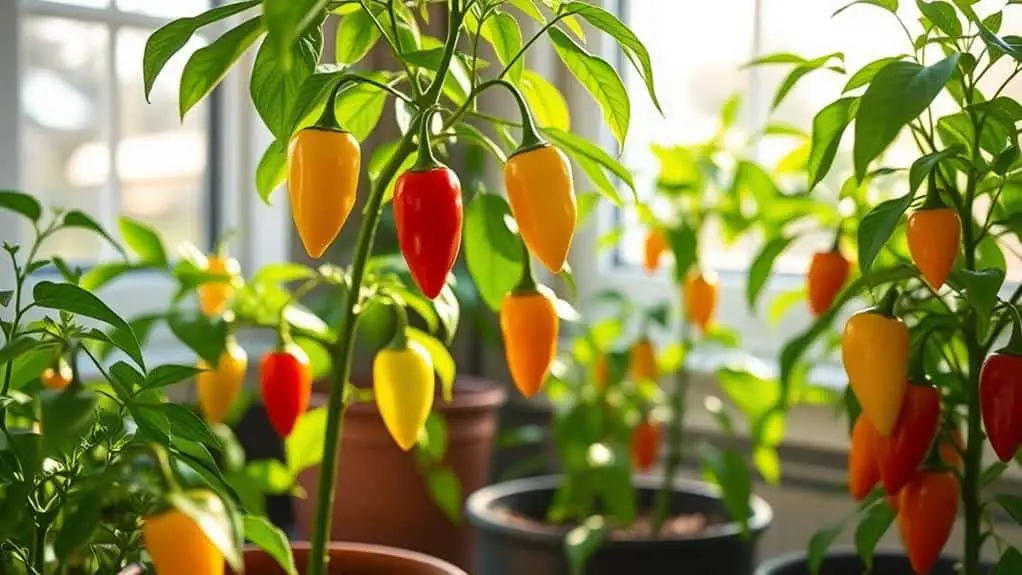
Cultivating peppers indoors can be a rewarding experience, offering fresh produce year-round. Peppers thrive in containers that are at least 12 inches wide, with good drainage. They need 6-8 hours of direct sunlight or a grow light.
Here's a simple guide:
- Planting: Start with seeds or small plants. Plant 2-3 seeds per pot in nutrient-rich soil.
- Watering: Guarantee consistent moisture, but don't overwater. Root rot is a risk.
- Temperature: Keep the environment between 65-75°F.
- Pollination: Hand-pollination may be needed. Gently shake plants or use a small brush to move pollen.
With these steps, you'll enjoy fresh, homegrown peppers all year long. Happy gardening!
Spinach Greens
Imagine having a steady supply of fresh, nutritious spinach right from your windowsill. Growing spinach indoors is easier than you think!
Start by using shallow pots that are at least 6 inches deep to give the roots enough room. Spinach loves cool environments and needs about 4-6 hours of direct sunlight each day.
Sow the seeds about 1/2 inch deep in moist soil, and they'll germinate in 7-14 days with regular watering. Once the leaves reach 2-3 inches long, you can start harvesting by picking the outer leaves, letting the inner ones keep growing. This way, you'll enjoy multiple harvests.
Packed with iron and vitamins A and C, spinach is a fantastic addition to your indoor garden!
Frequently Asked Questions
What Fruit Can You Grow Year-Round Indoors?
You can grow indoor fruit year-round with container gardening and hydroponic systems. Meyer lemons, strawberries, and cherry tomatoes thrive indoors. Focus on climate control, light requirements, and proper soil selection for the best results.
What Vegetables Can Be Grown Indoors All Year-Round?
You can grow lettuce, kale, carrots, spinach, and herbs indoors all year. I use container gardening, indoor hydroponics, and grow lights with soil alternatives. Effective pest management and seasonal planting guarantee a bountiful harvest.
What Fruits and Vegetables Can I Grow Inside My House?
You can grow Meyer lemons, tomatoes, strawberries, kale, and microgreens indoors. Follow indoor gardening tips like container gardening essentials, indoor light requirements, soil types selection, pest control methods, and seasonal planting strategies for success.
What Fruits and Vegetables Can Be Grown All Year-Round?
You're curious about year-round harvests? For indoor gardening tips, try tomatoes, lettuce, strawberries, herbs, and kale. Master container planting techniques, choose the right soil, optimize indoor lighting options, and employ pest management strategies for success.
Conclusion
Growing your own fruits and vegetables indoors year-round is a wonderful way to enjoy fresh produce no matter the season. With options like Meyer lemons, tomatoes, and spinach, you'll have a bountiful garden at your fingertips. Remember to provide plenty of light, water regularly, and maybe even hand-pollinate your plants. It might seem challenging at first, but with patience and care, you'll soon be harvesting delicious, home-grown food. You've got this, and happy gardening!

